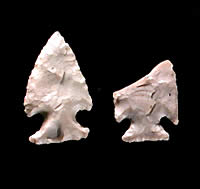
Scallorn arrow points from the Harrell site. Small but
deadly, arrow points such as these were found amid the
bones of several individuals and were very likely the
cause of their death. Photo by Milton Bell.
Click images to enlarge
|
|
In contrast to the sweeping warfare implied in the
evidence from the desert Southwest, most of the violent
prehistoric deaths in the southern Plains, including
Texas, appear to be the result of relatively small-scale
raids.
|
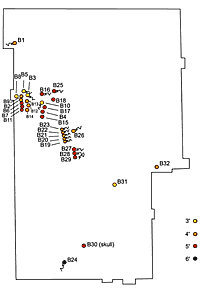
Map of burials at Harrell Cemetery,
showing depths and arrangement of some of the graves.
Although analysts recorded the remains of 32 individuals,
many skeletons were weathered, disarticulated, and incomplete.In
some graves, body parts of several individuals were
intermingled. Adapted from field drawings; Fox 1938,
TARL Archives.
|
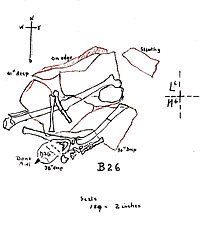
Several feet to the southeast of
the mass burials 19-23, the burial of an adult female
(burial 26) was found. She had been placed within a
stone cist, her legs extended and upper torso folded
over. A bone awl was discovered near her head. Adapted
from field drawings; Fox 1938, TARL Archives.
|
|
On removing the bones, in the earth below were skeleton
hands—seemingly Burial 23 clasped the hand of Burial
22. George Fox, 1938.
|
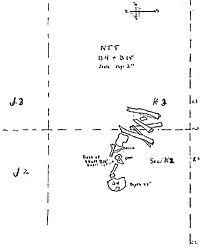
Bones of parts of some individuals
were found mixed within the skeletal remains of others,
as in this grave holding burial 4 and a skull fragment
of burial 15. Drawing from Fox, 1938; TARL Archives.
|
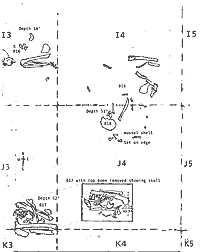
Burials of three individuals were
found in close proximity, as shown in this drawing.
The compact arrangement of bones at bottom left is termed
a "bundle burial." The remains of that individual
likely had been bundled into a mat or covering and carried
to the cemetery from another location (the inset box
shows the burial after excavators removed the top bone,
revealing the skull).
|
|
How the mandibles, or jawbones, of the dead were
treated at the Harrell site indicated a more ritualized
pattern, clearly not a phenomenon of weathering or nature.
|
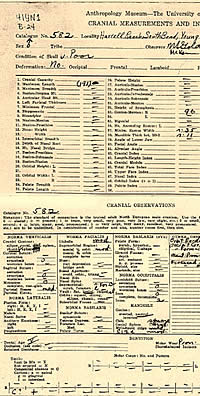
One of the hundreds of Cranial Measurement
and Observation data cards completed by Marcus Goldstein,
on file at TARL Archives.
|
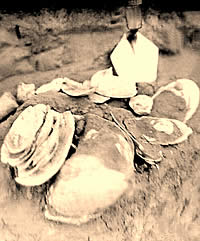
A cache of mussel shells was found to the southwest
of burial 11 and near hearth 4. More than likely, they
were put aside.
|
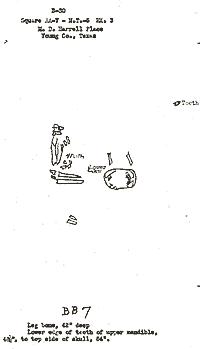
Burial 30, another possible reburial
or "bundle burial". Drawing from Fox, 1938;
TARL Archives.
|
|
Violence was clearly afoot in prehistoric Texas
and neighboring regions some 1100 years ago and for centuries
thereafter. We don't fully understand the nature of the conflicts,
the triggering causes, or what carried the hostile impulse
across the southern Plains and far south into central and
coastal Texas. What we do know about this seemingly abrupt
behavioral shift comes chiefly from graves. In small cemeteries
of this time period, archeologists have found widespread evidence
of killing and tell-tale evidence of the instrument of death—arrows
tipped with small stone points—within the graves or even
embedded in the skeletal remains. Some skeletons show more
horrifying signs of violence—crushed skulls, decapitation,
and missing limbs. Taken together, this evidence shows that
during a three- or four-century span between about A.D. 900
and 1200-1300 killing and violence were widespread across
prehistoric Texas, a pattern that is also seen in the Southwest
in the A.D. 1200s and 1300s.
While humans have been killing one another throughout
recorded history and probably the entire span of prehistory,
direct evidence of violence is not seen at most Native American
sites in Texas. Aside from burned houses, which may or may
not have been intentionally set afire in anger, the only way
we can spot violence in the archeological record is through
studying human remains. Analyses of human remains found in
other areas of Texas, especially in the central coastal plains,
suggest that violence began to increase during Late Archaic
times about 2000-3000 years ago. While we will never know
what triggered individual episodes, increasing violence is
generally thought to reflect increasing competition for resources
brought about by population increase sometimes coupled with
deteriorating climatic conditions that forced people to intrude
into the territories of others. This is a plausible big-picture
explanation for what happened in the southern Plains in Late
Prehistoric times.
One of the most obvious changes that distinguishes
the Late Prehistoric way of life from the longstanding, earlier
Archaic pattern is a change in weaponry systems, from the
ancient spear-throwing device called an atlatl, to the bow
and arrow. Researchers believe this transition occurred gradually,
beginning with the "self" or simple bow (not recurved),
and that hunting peoples may have used both types of weapons
for some period of time. While Plains Indians apparently adopted
the bow and arrow well before the time of Christ, south of
the Red River the transition to the bow and arrow did not
occur until after A.D. 500. By the 1200s a more powerful
type of bow, the recurved bow, began to be used. But other
lifeway changes were probably more fundamental. The introduction
of pottery making allowed people to more easily create containers
and cooking vessels that could be exposed directly to fire,
thus changing (and improving) the way certain foods were prepared.
Even more important was the spread of agriculture, which gradually
allowed (or forced) people to stay in one place for longer
periods.
These changes were neither simultaneous nor
uniform across the southern Plains. But as the societies were
transformed from old ways of life to new, violence became
widespread, particularly during the period between about A.D.
900 and 1300. At Southwestern pueblos, there is indication
of all-out warfare or large-scale killing during the A.D.
1200s and 1300s. Archeologists in New Mexico and Arizona have
studied the ruins of large defensively fortified pueblos that
had been burned to the ground. At pueblo sites such as Techado
Springs in west-central New Mexico, there were piles of unburied
skeletons—many of them young women—apparently laying
as they fell during an attack or massacre hundreds of years
ago. In some Southwest sites, victims had been scalped, and
in others, body parts had been taken, perhaps as war trophies.
Across the southern Plains, the scale of violence
that occured during this time may have been more extreme than
archeologists previously thought. Archeologist Doug Boyd believes
there is ample evidence of devastating raids and attacks,
mutilations, and the taking of body parts as trophies in the
burial data. Although Boyd notes that southern Plains populations
may have been lower than in the Pueblo world, "intertribal
warfare was every bit as important and destructive."
Arrow Points among the Graves
At the Harrell site, the signs of violence were
unmistakable. In the small cemetery overlooking the Brazos
River, skeletons bearing signs of arrow wounds (or with points
lying nearby) were found within three or possibly four mass
graves. According to the very cautious field analyst's description,
arrow points in one of the mass burials were found "in
such positions as to suggest death from wounds." His
notes continue:
The skeleton of B19 had an arrowpoint lying
between the ulna and radius of the right arm and a second
point lay between the ribs. In the section of the backbone,
B-20 had a point protruding from the spinal column; it entered
from the left side, slightly forward of the spine and when
found, protruded from the back at a slight angle downward.
Perhaps the group burials, or mass graves, were
a hasty means of interment of several individuals who had
been killed in a conflict with outsiders. But, in haste or
not, the care shown for the dead is evident in how some of
the graves were arranged. In the largest group interment (shown
in the top photo, burials 19-23), two young men, their bodies
flexed, had been arranged to face a small child who lay between
them (burials 21-23). One of the adults—his pelvis pierced
by an arrow tip—appeared to clasp the hand of the child who,
archeologists noted, had a badly crushed skull. Another two
individuals, also victims of arrow wounds, were laid close
together in "spoon fashion," their knees drawn up
and almost interlocked. Finally, the entire grave had been
covered over with large limestone slabs, grinding slabs, and
smaller rocks.
Nearby, a second slab-covered grave (burials
27-29) held the incomplete remains of three individuals who
had been placed in the grave in similarly close fashion. Investigators
discovered an arrow point lying roughly in the area of what
would be the central man's lung or spine area, or possibly
the arm of the adjacent individual. Five other arrow points,
described as long, narrow, and thin (Scallorn type), and a
number of mussel shells, some used as tools, were found among
the skeletal remains of the other two individuals.
Another possible mass grave held the remains of perhaps six
individuals, their body parts layered atop one another in
a puzzling arrangement. One individual and a child (represented
primarily by skulls and leg bones) lay in a flexed position
beside another burial (represented by only a skull.) Resting
atop the thigh area of the two flexed skeletons were the leg
bones of another individual, and lying over the shoulder area
were two more sets of legs from yet other individuals. Although
some might speculate that the elements laying on top might
have been intrusive later burials, archeologist Fox noted
the alignments of the higher bones: "Either these bones
were placed with extreme care so as to have them in correct
position, or the limbs were yet in flesh when buried."
During excavations in the area (Excavation 3, which also included
the hearth field), investigators uncovered the remains of
32 individuals in all. Although the depths of the graves varied,
they all were within the upper deposits and apparently formed
a series dug in from the same surface, suggesting a burial
ground in continuous use by the same peoples. Few of the graves
intruded into one another—possible evidence that the
cemetery was a designated place and that the grave locations
were marked or well remembered. The tight grouping also suggests
that the graves are roughly contemporaneous and probably occurred
within a few generations.
Beyond that, however, the interments varied
radically: while 16 graves contained only one individual,
four bore the multiple interments discussed above. Another
grave—a likely reburial—was compressed into what
is termed a "bundle burial." It is likely that this
individual died elsewhere and the bones were brought back
to the Harrell site sometime thereafter. Other graves had
stone coverings, a few may even have been placed into a slab-line
enclosure or box-like cist. In one, an older woman (Burial
26) had been placed in an unusual position with legs extended
and upper body bent forward over the legs. The remains were
in poor condition and a number of elements were missing. Against
the top of the skull, excavators found what they termed a
bone awl (likely a hairpin). Although the grave was just southeast
of the mass burials numbered 19-23, it was several inches
higher than the others, and Fox was uncertain whether it was
related to the same burial event.
Archeologists studying the human remains at
the cemetery noted that the skeletons, as a group, were poorly
preserved; they could not determine whether this was due to
ordinary decomposition alone. There are several indications
that bodies or skeletons were dismembered or buried in an
already fragmented condition. In five, there was no sign of
the skull; two others contained merely skull fragments; one
had several teeth and a few bone fragments; several others
contained only sections of leg bones. In four, the skulls
had been carefully placed crown down, presumably after they
were no longer connected to the spine. Archeologist Fox wrote
that the inverted skulls were "so definitely in position
that the theory that a settling of the overlapping earth displaced
the skulls is untenable."
How the mandibles, or jawbones, of the dead
were treated at the Harrell site indicated a more ritualized
pattern, clearly not a phenomenon of weathering or nature.
In six graves, jawbones were absent even though the skull
was otherwise well preserved; in several others the jaws had
been removed and placed in the grave separately. In another,
more bizarre instance, the lower mandible appeared to have
been turned around and set in place inside the skull.
Displacement and removal of mandibles in burials,
whether a ritual among the aggressors or the families of the
aggrieved, has been fairly widely documented in other cemetery
sites across the region. Based on absence of mandibles in
graves from the Abilene area and farther west, early avocational
archeologist Cyrus Ray speculated that the jaws might have
been "war trophies." There is evidence for this
type of practice in the East Texas area as well.
Enigmatic cut marks on several of the Harrell
skulls have raised the possibility that the individuals may
have been scalped. Both Drs. Michael Collins and Darrell Creel,
who briefly examined the specimens under less than ideal light,
found the marks possibly to be suggestive of scalping but
altogether inconclusive. A more-thorough examination is needed
to fully understand and interpret the condition of the skeletal
remains from the site.
Funerary Objects
Throughout the cemetery, there were only scant
signs of what archeologists term "offerings" or
funerary objects, the special items sometimes placed with
the dead. Even then, the investigators could not be sure whether
the items had been worn by the individual, were embedded in
the body, or were laid into the grave with the body. As lead
investigator Fox describes their placement:
The grave offerings were very few; but with
three exceptions, doubt is entertained as to their being purposely
interred with the body. Within one grave, a bone awl stood
against a skull. In another, a small scraper lay beneath the
pelvic bone. In a third, two points, well made, were close
to an arm bone, in such a position as to indicate the two
arrows buried with the dead.
And further:
A bone bead was beneath the central portion of one grave
with two mussel shells, nested, not far away… In another
grave, about 12 inches from the bones, a mussel shell was
erect in the clay, standing on its pointed end. In yet another,
the mussel shell was set on edge….
At the north end of the cemetery, Fox recorded a number of
possible post-hole stains in the area of several graves with
very incomplete skeletal remains. The stains were in groups
or clusters; several appeared aligned in rough arcs. Although
neither Hughes nor Krieger addressed these features, it is
possible they may represent the supports for some sort of
mortuary structures or part of a larger building.
Aside from their obvious human interest, the
Harrell site graves are significant from a larger perspective.
In north Texas and further west across the southern Plains,
a number of sites bearing similarities to the Harrell cemetery
have been reported. Most of the graves seemed to be Late Prehistoric;
individuals usually were placed in the grave in a flexed position
and covered with stone. As at the Harrell site, some were
multiple graves in a single large grave, and some lacked mandibles
and other body parts. In rare cases, objects or grave "goods"
were added. Because of these similarities, we suspect that
the Harrell cemetery dates to roughly A.D. 1000-1300 in the
transitional period between the early part of the Late Prehistoric
period and the Plains Villager era which was the Harrell site's
heyday.
|
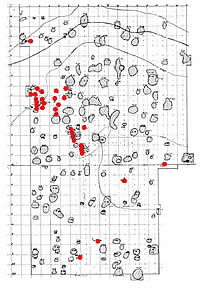
The small cemetery was located on the western
edge of the ridgetop habitation area-a maze of hearths,
pits, and refuse deposits accumulated over thousands of
years. Some evidence suggests, however, that the cemetery
may date to a more-limited time span somewhere between
A.D. 1000 to 1300. Map adapted from Fox, 1938; TARL Archives.
|
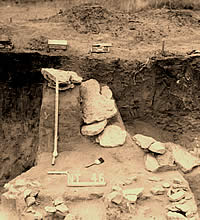
Partial grave covering of Burials 19-23. The limestone
slabs and grinding stones had been laid over portions
of the bodies of three adults and a child. Photo from
TARL Archives. |
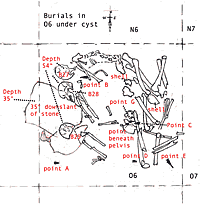
A 1938 field drawing of a multiple
burial (27-29) records the close position of the individuals
and the arrow points which likely killed them. Adapted
from Fox; 1938, TARL Archives.
|
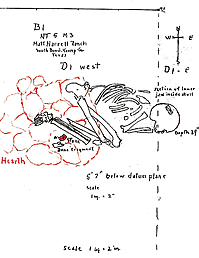
The individual in Burial 1 was found in a flexed
position with arms bent up and hands before the face.
A section of the lower jaw was found inside the skull.
Excavators found a flat stone "platform or hearth,"
with a small amount of ash, roughly 9 inches below the
lower part of the body. Drawing adapted from Fox, 1938;
TARL Archives. |
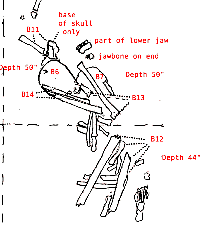
Remains of perhaps as many as seven individuals
were recorded in this burial. Drawing from Fox, 1938;
TARL Archives.
|
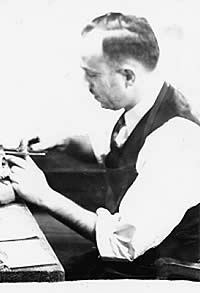
Physical anthropologist Marcus Goldstein,
shown in his laboratory at the University of Texas,
circa 1938. The cranial data he gathered provides information
on the sex, age, and condition of many of the skeletal
remains from sites such as Harrell. Photo from TARL
Archives.
|
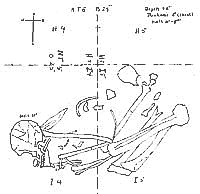
The burial of an adult man (burial 25) who was
judged to be roughly 35 years old and appeared to be
"low-vaulted" to Marcus Goldstein, who performed
the cranial analysis. Drawing from Fox, 1938; TARL Archives.
|
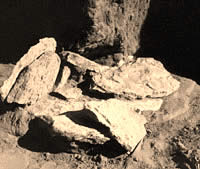
Stones covering burial 25. Photo from TARL Archives.
|
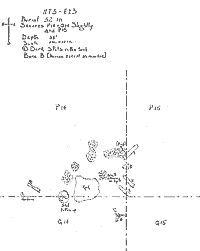
To the east of the more defined cemetery
area, excavators found human remains in an apparent
refuse pit. Burial 32 consisted of little more than
an inverted skull, a displaced jaw bone, and leg bones
lying in the midst of shell and animal bones, a stone
slab, and what were recorded as dark spots in the soil.
One of the human leg bones was described in the records
as gnawed, suggesting the body had been left unburied
for some period of time—long enough for rodents
to disturb. Adapted from Fox, 1938; TARL Archives.
|
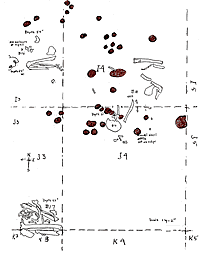
A pattern of small circular soil
stains in the cemetery was thought to represent postholes.
If so, the posts may have been supports for small mortuary
structures or for a larger building.
|
|